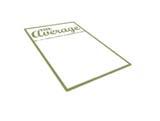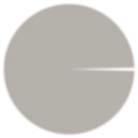








































































Sustainability Report Kroonpress Ltd. 2011
Introduction 3 What we do 4 Environmental policy 5 2010 in brief 6 The average printed product 7 Paper at Kroonpress 8 Paper waste 8 Facts about recycled paper 9 Prints and misprints 9 Emissions 10 Air emissions 10 Wastewater 10 Inks and chemicals 11 Aluminium 12 Energy 13 Electricity 13 Natural gas 13 Central heating 13 Transportation 14 Carbon footprint 15 In this report Kroonpress Ltd. 133 Tähe St., 51013 Tartu, Estonia. Phone (+372) 730 5100 , fax (+372) 730 510, order@kroonpress.eu Environmental affairs: Sander Jahilo, phone (+372) 591 99 198 E-mail: sander.jahilo@kroonpress.ee Visit our website at www.kroonpress.eu. Kroonpress Ltd. was founded in 1990 St , , www.kroonpress.eu .
Introduction
When it comes down to environment, there is a lot more we can accomplish than just following regulations and applying for certificates. A common misconception is that paper manufacturing is the source of all evil in the printing industry. Paper producers in Northern Europe have made big steps towards becoming less carbon-intensive, and many have succeeded. It is now evident that for a printed product to be sustainably produced, all steps in the production chain have to improve their environmental performance. This is where we try do our best.
At Kroonpress, we began minimising our environmental footprint ten years ago by implementing certified quality and environmental management systems. Step-bystep, we began investing in state-of-the-art hardware and know-how which has enabled us to become the most efficient printing press plant in the Baltics

But use of the latest technologies, methods and environmental standards is just one of the many tools enabling us to embrace the idea of sustainability.
The following pages will give you an overview of what and how much we produce compared to the environmental load we generate. We hope you enjoy reading!
3
Mitigating climate change is a joint effort of both industry and market
What we do
We are a printing press plant with a colourful history. Kroonpress began operation in turbulent times, during the collapse of the Soviet Union, in 1990, out of a need to start printing the largest national daily newspaper –the Postimees. National independence was not regained until 1991 but the Postimees was aspiring to become an independent newspaper nevertheless, which meant economic repressions from the central government – the Postimees had to start handling all its procurements on its own, unlike other national papers that continued to be printed in statecontrolled printing plants
The environment was not an issue back then The nation along with its hectic economy was preoccupied withgetting on its feet and environmental concerns were not acknowledged or were viewed upon as “soft“ issues that would have to be dealt with some other time.
Kroonpress is now the largest printing plant in the Baltics by both volume and turnover. We still print the Postimees but along the way a lot has changed. Hardly any of the hardware used in the 1990s has remained; we’ve built new production facilities and completely refurbished the production units.
We now have a total of four printing machines which have been constructed between 1998 and 2008, enabling us to print coldset, heatset and sheet-fed offset newspapers, magazines, brochures, etc. Our staff of 260 people produce over 600 million copies of print products each year. Our annual turnover in 2010 was 33 million euros.

4
Over 1.5 million prints leave our plant each day
Environmental policy
We are proud to be adhering to the requirements of the environmental management certificate ISO 14001, quality management certificate ISO 9001, Forest Stewardship Council (FSC) certificate, Programme for the Endorsement of Forest Certification (PEFC) scheme and the Nordic Ecolabelling license.

ISO 9001 quality management systems standard aims to enhance customer satisfaction through the effective application of the quality management system
ISO 14001 environmental management systems standard specifies requirements for an environmental management system to enable an organisation to develop and implement a policy and objectives which take into account legal requirements and other requirements to which the organisation subscribes, and information about significant environmental aspects.
ISO 9001:2008
FSC and PFC certification ensures that forestry operations meet a set of environmental, social and economic criteria covering compliance with laws and international treaties, land-use and indigenous peoples’ rights, community relations, biodiversity conservation and maintenance of high conservation value forests, among other things.

ISO 14001:2004

The Nordic Ecolabel is the Nordic countries’ official environmental ecolabel
It assesses the entire environmental impact of aprinting company’s activity –everything from the choice of paper approved by the Nordic Ecolabel to good practices in making work environmentally friendly

FSC PEFC Nordic
2001 2001 2008 2009 2010
Ecolabel
5 Year
The Nordic Ecolabel license was granted to Kroonpress in 2010
Kroonpress operates at 86% load capacity


2010 in brief
2010 was a successful year for us Production efficiency has been growing ever since the installation of the newest printing press in 2008 and we have now reached an average 86% of our full capacity, which
Here’s the amount of resources we used in 2010:
means the capital goods within the plant are being used efficiently with minimum downtime, which, in turn, decreases energy and material waste and increases the useful lifespan of machinery and other equipment.
27 620
Equivalent to the weight of 3.8 Eiffel Towers





83 tonnes of aluminium
Equivalent to the weight of 5.7 unladen London double-deckers



double MWh
6 737 m3 of H of electricity















Equivalent to electricity production from two 1.5 MW air turbines (height 80 m) at 30% efficiency











tonnes of paper tonnes of ink
Equivalent to the volume of 2.4 average hot air balloons





710
Equivalent to the weight of the statue of Christ the Redeemer in Rio de Janeiro


924 074 m of natural gas

Equivalent to the volume of 4.6 Hindenburg airships






6
Ink makes up roughly 2.5% of the weight of a printed product
The Average is something you won’t find in stores. It is an imaginary piece of journalism that represents the average consumption of materials and energy per printed product at our plant It roughly represents the average newspaper or light-weight magazine.


weight 46 g
Electricity equivalent of a 60 W light bulb staying lit for 12 minutes
1.5 litres of natural gas
1
gram of ink
0.011 litres of water
The average printed product 7
Facts about recycled paper
Recycled paper has always been a hot topic Here are some intriguing facts about recycling which might help you approach the issue with greater rationale:
Paper cannot be recycled endlessly. About 5 cycles is the limit for a single fibre until it deteriorates entirely and is thereafter only good for incineration or biogas production (both of which are used for energy generation).
For any recycled paper product, the contents of the paper has to be a mixture of different grades of fibre – if a product were entirely produced out of fibre that was on its 5th cycle, the product would wear and tear very quickly.
Hence, virgin fibre products have to be continuously added to the recycling process to maintain paper quality. Virgin magazine paper is usually of very high quality with excellent strength and endurance, thus making it a very desirable raw material for recycling.
To produce recycled magazine paper of equal quality of virgin paper, a lot of chemicals and energy have to be used, while packaging, newspapers and hygiene products are not so demanding on the quality of recycled paper, thus consuming less energy and generating a smaller carbon footprint.
Life cycle analysis has shown that when printing on paper from low-carbon paper mills, buying paper products will actually enable consumers to sequester carbon. Average magazines sequester about the same weight of CO₂ in its fibres as is its paper weight.
Prints and misprints
Misprints are produced during printing press start-up and occur mostly due to paper malfunctioning, paper/print defects or operator error. Wasted paper is the biggest contributor to waste production and enlarges our carbon footprint as well



Heidelberg Speedmaster Goss Baker Goss Universal KBA Compacta 20 mio. 102 mio. 111 mio. 377 mio. Copies produced in 2010 Average waste produce per all presses: 11%
Paper fibre can be recycled about 5 times
9
Emissions


Our air emissions arise mostly from the inhouse gas dryers that burn gas for drying ink and paper Fortunately, natural gas is a fairly clean fuel, although it still produces considerable amounts of CO₂ Gaseous emissions also emit from inks and solutions that contain volatile organic compounds (called VOCs, for short), which
under high temperatures evaporate from the ink, leaving the solid ink embedded in the paper Fortunately, most of the VOCs are captured within the printing press and are incinerated, turning the harmful products into ordinary flue gases. However, not all VOCs are captured and some escape into the atmosphere through ventilation.
Direct emissions into air in 2010, tonnes
Water in production is only used for providing and maintaining a fixed moisture content for the paper in the printing process, also for washing the rollers and production lines. In 2010 the amount of water consumed at our plant was 6 737 m3. Approximately two-thirds of this was used for household use (bathrooms, showers, etc.) and was directed into the local wastewater treatment system The other third was utilised in production. As there is no run-off with moisturising, there is no industrial wastewater at our plant. Water used for various solvents, cleaning and washing processes is contained and delivered to chemical substances handlers in
•
sealed containers. Thus, our outgoing wastewater analysis results resemble average households.
• Currently, we draw our water from the local groundwater-based water supply but 2012 should become a turning point for us – we will begin utilizing the ample resources of our grey skies! Rainwater will be collected from all of our 9000 m2 of roof area and this will be sufficient to cover most of our monthly water needs, and in some months even generate a surplus.


NO₂ 3 t CO₂ 2231 t CO 2 t VOC 14 t
99%
of our air emissions are CO₂
Air emissions
10
Wastewater
Inks and chemicals
Most of the chemicals used at Kroonpress are ink solvents, detergents, varnishes and moisturisers
The consumption of isopropyl alcohol (IPA) was about 7.5 tonnes in 2010.
All chemical waste is collected in-house and handed over to a chemical waste handler. A total of 69.5 tonnes of chemical waste was produced in 2010, consisting mainly of various solvents and water suspensions.
We use four types of inks manufactured by the Sun Chemicals Corporation (World Series, Polar Advantage, SunOne, SunMag)

The sheet-fed printing press uses World Series Diamond inks which are mineral-oil free, containing only vegetable oils and resins. It is also 100% VOC-free
The other three inks are mineral-oil based and contain VOCs. We also use a total of several tonnes of spot inks for custom prints but due to the large variety (several hundred products) the environmental data for all these is yet to be collected.
Most of the VOCs produced during printing are captured at the spot and incinerated, producing ordinary flue gases, mainly CO₂. This increases our carbon footprint but is a better option than letting the VOCs into the atmosphere where they pose a much more immediate risk, depleting ozone, forming smog and increasing respiratory disease risk for humans and other living organisms.
• Other chemical wastes generated include glue, chemically contaminated packaging, cleaning agents, small amounts of batteries and electronic equipment, etc.
11
70 tonnes of chemical waste was generated at Kroonpress in 2010
Aluminium
It might come as a surprise to include aluminium in an environmental report but due to the energy-intensity of aluminium production it is a significant contributor to our indirect carbon footprint
Aluminium is the main component of printing plates that are used in our preprinting department for creating the blueprints of a paper print. The printing plates are covered in a photoactive emulsion that is fed into a digital plate printer. These are then fed into the printing presses to begin printing. Our printing plates endure up to several hundred thousand copies per run. However, each plate can only be developed (or “printed“) just once, which means the annual consumption of these plates is fairly high – 83.5 tonnes in 2010.
Printing plates, like high quality paper, are still made from virgin raw material to ensure the highest purity and print quality. Even though aluminium can be recycled endlessly and Kroonpress delivers 100% of our purchased printing plates to recyclers, the environmental cost of manufacturing virgin aluminium is quite large, mostly due to high fossil energy consumption.
Therefore, even though our usage of aluminium printing plates does not affect the environment directly, we are responsible for the environmental impact that happens due to our demand for printing plates. We hope printing plate manufacturers will respond to the demand for more eco-friendly products.

12
Aluminium can be recycled infinitely
The main energy inputs in our printing process are electricity and heat. Electricity consumption at our printing plant is stable throughout the year with an annual consumption of 7.5 GWh.
At the moment, our electricity comes from the national grid and is mainly produced from fossil oil shale which is a powerful source of greenhouse gases. Even though our facility and production is efficient and clean, we do not neglect the impact of our share of electricity production that is purveyed due to our demand. Plans are in motion to start using renewable electricity in 2012. Until then, we must face the fact that the emissions for producing our share of electricity was 6 600 tonnes of CO₂equivalent, thus making it accountable for the largest share in our carbon footprint (see page 14 for more)
• Heat is generated by in-house heaters and central heating
• As paper is susceptible to changes in air moisture and is prone to deformations which may render entire reels of paper unusable or bring about misprints, correct moisture and temperature levels must be maintained in both storage and production areas. We are connected to the local central heating grid and in 2010 we consumed a total of 1 088 MWh of heat energy, whereas the difference in consumption between summer and winter varied by up to 25-fold.
• Out of this heat energy, 62% was produced carbon-neutrally, using biomass such as wood chips and other waste from forestry. The carbon dioxide equivalent in emissions from the remaining 38% of heat was 180 tonnes per year.
Natural gas is used in gas dryers and ovens in heatset printing presses where the heat dries the ink and paper of fresh printed products. As a fuel, natural gas produces CO₂, even though per delivered joule this amount is lower than for any other fossil fuel. Fortunately, natural gas is a lot cleaner in terms of sulphur dioxide and nitrogen oxide emissions which cause acidification and smog.
The annual natural gas consumption at Kroonpress in 2010 was 924 074 m3, producing 2 231 tonnes of CO₂-equivalent.

Electricity Natural gas Central heating 13
Energy 2012 will see Kroonpress become a renewable electricity consumer
Kroonpress is studying the replacement of diesel trucks with natural gas vehicles
Transportation
We use our own drivers and diesel vehicles to deliver domestic products such as daily and weekly newspapers and magazines. For this purpose we have eight vehicles of varying load capacities from 15 to 2.5 tonnes.
Since we are not responsible for the transport of raw goods to Kroonpress and

export delivery is outsourced to logistics services, we don’t know the total consumption and travelled kilometres of these steps of our production.
• We hope to include the outsourced transportation emissions in our future carbon footprint analyses.

(or 2.5 times to the moon and back)
litres of diesel
(or a volume of 7.3 average railroad tank cars)








at an average fuel consumption of 22.35 litres/100 km,

emitting 543 tonnes of CO₂
(or the weights of 2.7 Statues of Liberty)


and delivering approximately 12 600 tonnes of print products
(or the weights of roughly 62 Statues of Liberty)
In 2010, our vehicles drove a total of 978 000 km, consuming 218 590
14









































































